Location Hunting Game: Developing an Application to Promote Gameful Hybrid Machi-aruki Town Exploration
Abstract
1. Introduction
1.1. Machi-aruki: A Participatory Practice of Building a Common Ground
1.1.1. Definition of the Terms Machi-aruki and Machizukuri
1.1.2. Steps and Goals of Machi-aruki Practices
1.1.3. Walking Tours as a Participatory Planning Practice in Other Contexts
1.1.4. The Use of ICT Tools and Location-Based Technologies in Machi-aruki
1.2. Hybrid Forms of Participation in Urban Planning
1.3. Local Knowledge in Participatory Planning
1.4. Gameful Design and Gamification in Participatory Urban Planning and Design
1.5. Aims and Objectives
2. Materials and Methods
Machi-aruki Using Bicycles: An Experimental Aim of the Current Version of LHG
3. Results
3.1. Conceptual Design of LHG
3.2. Technical Specifications
3.3. Prototyping and Interface Design Process
3.4. The Gameplay in LHG
3.4.1. Riding the Bicycle
3.4.2. Hunting Locations
- Blue routes: indicating all the previous bike rides completed within the game, where the challenge of the hunting locations is over.
- One red route: indicating the selected active game route, within which the photo shown on the interface was taken somewhere. This route serves as an indication of the range within which players should hunt the hidden location of that photo. On top of the red line, GPS points are visualized as transparent white circles, making the overlap of these circles identifiable. The distance between these circles is an indication of the speed of the bicycle, and the overlap is an indication of a stop, which could be made to take a photo.
- Orange routes: if available, indicate other simultaneously active game routes. They signal the players of the existence of other photos that they can hunt. By using the arrows left and right on the interface, players can move from one photo to another. By doing so, the orange routes turn red accordingly.
- Blue flags: indicating the photos of which the locations were successfully guessed by a player whose username is written on the flag.
- Purple flags: indicating that no player could guess the location successfully, in which case, the username of the bicycle rider who shared the photo is displayed on the flag.
3.4.3. Voting for Locations
3.5. Summary of Preliminary Results from a Trial Study
4. Discussion
4.1. The Added Value of LHG
4.2. The Desired Outcomes of LHG
4.3. Future Research Steps
- Analysis of pre- and post-survey data, with a specific interest in the initial motivation of participants and its relationship with their engagement with the app, and their evaluation of the participation experience.
- Analysis of the qualitative data gathered mainly via online group discussions, in addition to field observations and written feedback from participants.
- Evaluation of LHG as a machi-aruki tool, looking at which characteristics were successful in achieving the desired tangible and non-tangible outcomes of machi-aruki, and which were less successful and need to be improved and bettered.
5. Conclusions
Author Contributions
Funding
Data Availability Statement
Acknowledgments
Conflicts of Interest
References
- Yukiko, T. The Machi Aruki Walk まち歩きfor the Prevention of Catastrophes–An Example of Risk Prevention Education in a Recent Disaster Area in Kumamoto County, Japan. Paysage 2020, 23. [Google Scholar] [CrossRef]
- Satoh, S. Japanese Machizukuri and Community Engagement: History, Method and Practice; Taylor & Francis Group: Milton, UK, 2020. [Google Scholar]
- Kusakabe, E. Advancing sustainable development at the local level: The case of machizukuri in Japanese cities. Prog. Plan. 2013, 80, 1–65. [Google Scholar] [CrossRef]
- Matsuura, M.; Watanave, H.; Sugisaki, K. Developing a Participatory Issue Identification Support System Using Mobile Phones: Experiments with “umiaruki”. J. Sociotechnical Res. 2012, 9, 60–69. [Google Scholar] [CrossRef][Green Version]
- Yabu, K.; Miura, T.; Segawa, T.; Murakami, Y.; Nakahashi, T. Classifying Multigenerational Town Tours and Strolls for a Hyperdiverse Society: Case Studies in an Urban Educational District. In HCI International 2022–Late Breaking Papers: HCI for Health, Well-Being, Universal Access and Healthy Aging; Springer Nature Switzerland: Cham, Switzerland, 2022; pp. 599–607. [Google Scholar]
- Andersen, K.; Balbontín, S. A Walking Methodology as the Participatory Tool for a University Master Plan Design. In Experiential Walks for Urban Design; Springer International Publishing: Cham, Switzerland, 2021; pp. 289–301. [Google Scholar]
- Custers, L.; Huybrechts, L.; Devisch, O. Experiential Evaluation to Create Risky Situations and Address Tensions in a Participatory Planning Process. Urban Plan. 2023, 8, 292–306. [Google Scholar] [CrossRef]
- Miura, T.; Yabu, K.I.; Noro, T.; Segawa, T.; Kataoka, K.; Nishimuta, A.; Sanmonji, M.; Hiyama, A.; Hirose, M.; Ifukube, T. Sharing Real-World Accessibility Conditions Using a Smartphone Application by a Volunteer Group; Springer International Publishing: Cham, Switzerland, 2016; pp. 265–272. [Google Scholar]
- Nakano, J.; Osawa, S.; Narumi, T.; Tanikawa, T.; Hirose, M. Designing a walking tour utilizing on-site virtual time machine. Trans. Virtual Real. Soc. Jpn. 2017, 22, 241–250. [Google Scholar]
- Desouza, K.C.; Bhagwatwar, A. Technology-Enabled Participatory Platforms for Civic Engagement: The Case of U.S. Cities. J. Urban Technol. 2014, 21, 25–50. [Google Scholar] [CrossRef]
- Afzalan, N.; Muller, B. Online Participatory Technologies: Opportunities and Challenges for Enriching Participatory Planning. J. Am. Plan. Assoc. 2018, 84, 162–177. [Google Scholar] [CrossRef]
- Kleinhans, R.; Van Ham, M.; Evans-Cowley, J. Using Social Media and Mobile Technologies to Foster Engagement and Self-Organization in Participatory Urban Planning and Neighbourhood Governance. Plan. Pract. Res. 2015, 30, 237–247. [Google Scholar] [CrossRef]
- Falco, E. Digital Community Planning: The Open Source Way to the Top of Arnstein’s Ladder. Int. J. E-Plan. Res. 2016, 5, 1–22. [Google Scholar] [CrossRef]
- Yamu, C.; Poplin, A.; Devisch, O.; de Roo, G. (Eds.) The Virtual and the Real in Planning and Urban Design: Perspectives, Practices and Applications, 1st ed.; Routledge: London, UK, 2017. [Google Scholar] [CrossRef]
- Jones, P.; Layard, A.; Speed, C.; Lorne, C. MapLocal: Use of Smartphones for Crowdsourced Planning. Plan. Pract. Res. 2015, 30, 322–336. [Google Scholar] [CrossRef]
- Ikeda, S. Urban Interventionism and Local Knowledge. Rev. Austrian Econ. 2004, 17, 247–264. [Google Scholar] [CrossRef]
- Tayebi, A. “Communihood:” A Less Formal or More Local Form of Community in the Age of the Internet. J. Urban Technol. 2013, 20, 77–91. [Google Scholar] [CrossRef]
- Jiang, J.; Spencer, L.; Werner, L.C. Public Gratification Palace: A Framework for Increased Civic Engagement. In Media Architecture Biennale 20; Association for Computing Machinery: New York, NY, USA, 2021; pp. 131–140. [Google Scholar]
- Hemmersam, P.; Martin, N.; Westvang, E.; Aspen, J.; Morrison, A. Exploring Urban Data Visualization and Public Participation in Planning. J. Urban Technol. 2015, 22, 45–64. [Google Scholar] [CrossRef]
- Booher, D.E.; Innes, J.E. Network Power in Collaborative Planning. J. Plan. Educ. Res. 2002, 21, 221–236. [Google Scholar] [CrossRef]
- Akbar, A.; Flacke, J.; Martinez, J.; Van Maarseveen, M.F.A.M. Spatial Knowledge: A Potential to Enhance Public Participation? Sustainability 2020, 12, 5025. [Google Scholar] [CrossRef]
- Rantanen, H.; Kahila, M. The SoftGIS approach to local knowledge. J. Environ. Manag. 2009, 90, 1981–1990. [Google Scholar] [CrossRef]
- Fredericks, J. From Smart City to Smart Engagement: Exploring Digital and Physical Interactions for Playful City-Making; Springer: Singapore, 2020; pp. 107–128. [Google Scholar]
- Ryan, R.M.; Deci, E.L. Intrinsic and extrinsic motivation from a self-determination theory perspective: Definitions, theory, practices, and future directions. Contemp. Educ. Psychol. 2020, 61, 101860. [Google Scholar] [CrossRef]
- Jiang, H.; Geertman, S.; Witte, P. Planning First, Tools Second: Evaluating the Evolving Roles of Planning Support Systems in Urban Planning. J. Urban Technol. 2022, 29, 55–77. [Google Scholar] [CrossRef]
- Geertman, S.; Stillwell, J. Planning support systems: An inventory of current practice. Comput. Environ. Urban Syst. 2004, 28, 291–310. [Google Scholar] [CrossRef]
- Thiel, S.-K.; Ertiö, T.P.; Baldauf, M. Why so serious? The Role of Gamification on Motivation and Engagement in e-Participation. IxD&A 2017, 24, 158–181. [Google Scholar]
- Poplin, A. Playful public participation in urban planning: A case study for online serious games. Comput. Environ. Urban Syst. 2012, 36, 195–206. [Google Scholar] [CrossRef]
- Tan, E. The Evolution of City Gaming. In Springer Proceedings in Complexity; Springer: Cham, Switzerland, 2016; pp. 271–292. [Google Scholar]
- Devisch, O.; Poplin, A.; Sofronie, S. The Gamification of Civic Participation: Two Experiments in Improving the Skills of Citizens to Reflect Collectively on Spatial Issues. J. Urban Technol. 2016, 23, 81–102. [Google Scholar] [CrossRef]
- Deterding, S.; Dixon, D.; Khaled, R.; Nacke, L. From game design elements to gamefulness: Defining “gamification”. In Proceedings of the 15th International Academic MindTrek Conference: Envisioning Future Media Environments, Tampere, Finland, 28–30 September 2011; Association for Computing Machinery: New York, NY, USA, 2011; pp. 9–15. [Google Scholar]
- Gordon, E.; Walter, S. Meaningful inefficiencies: Resisting the logic of technological efficiency in the design of civic systems. In The Playful Citizen: Civic Engagement in a Mediatized Culture; Glas, R., Lammes, S., de Lange, M., Raessens, J., de Vries, I., Eds.; Amsterdam University Press: Amsterdam, The Netherlands, 2019; pp. 310–334. [Google Scholar]
- Leorke, D. Location-Based Gaming: Play in Public Space; Springer Singapore: Singapore, 2019. [Google Scholar]
- de Souza e Silva, A.; Hjorth, L. Playful Urban Spaces: A Historical Approach to Mobile Games. Simul. Gaming 2009, 40, 602–625. [Google Scholar] [CrossRef]
- Tabi, S.; Sakai, Y.; Nguyen, T.; Taima, M.; Cheddadi, M.A.; Ikeda, Y. A Framework for a Gameful Collective Urbanism Based on Tokenized Location Data and Liquid Democracy: Early Prototyping of a Case Study Using E-bikes. In Proceedings of the 27th CAADRIA Conference, Sydney, Australia, 9–15 April 2022; Volume 1, pp. 585–594. [Google Scholar]
- Sakai, Y. Bikebump: Collective Urban Design. Master Thesis, Massachusetts Institute of Technology, Cambridge, MA, USA, 2017. [Google Scholar]
- Ataman, C.; Tuncer, B. Urban Interventions and Participation Tools in Urban Design Processes: A Systematic Review and Thematic Analysis (1995–2021). Sustain. Cities Soc. 2022, 76, 103462. [Google Scholar] [CrossRef]
- Fallman, D. The Interaction Design Research Triangle of Design Practice, Design Studies, and Design Exploration. Des. Issues 2008, 24, 4–18. [Google Scholar] [CrossRef]
- Secinaro, S.; Brescia, V.; Iannaci, D.; Jonathan, G.M. Does Citizen Involvement Feed on Digital Platforms? Int. J. Public Adm. 2021, 45, 708–725. [Google Scholar] [CrossRef]
- Stieglitz, S.; Lattemann, C.; Robra-Bissantz, S.; Zarnekow, R.; Brockmann, T. Gamification: Using Game Elements in Serious Contexts, 1st ed.; Springer International Publishing AG: Cham, Switzerland, 2016. [Google Scholar] [CrossRef]
- Tsuchiya, K.; Suga, Y. Consideration on creating a platform for forming a relevant population- Case study from Hino City, Tokyo. Edogawa Univ. Bull. 2023, 33, 107–116. [Google Scholar]
- Utsu, K.; Ueta, S.; Tajima, S.; Kajita, Y.; Murakami, Y.; Uchida, O. Town-Watching Workshop Using Disaster Information Tweeting and Mapping System. Future Internet 2019, 11, 150. [Google Scholar] [CrossRef]
- Sorensen, A.; Funck, C. Living Cities in Japan: Citizens’ Movements, Machizukuri and Local Environments, 1st ed.; Routledge: London, UK, 2007; p. 320. [Google Scholar]
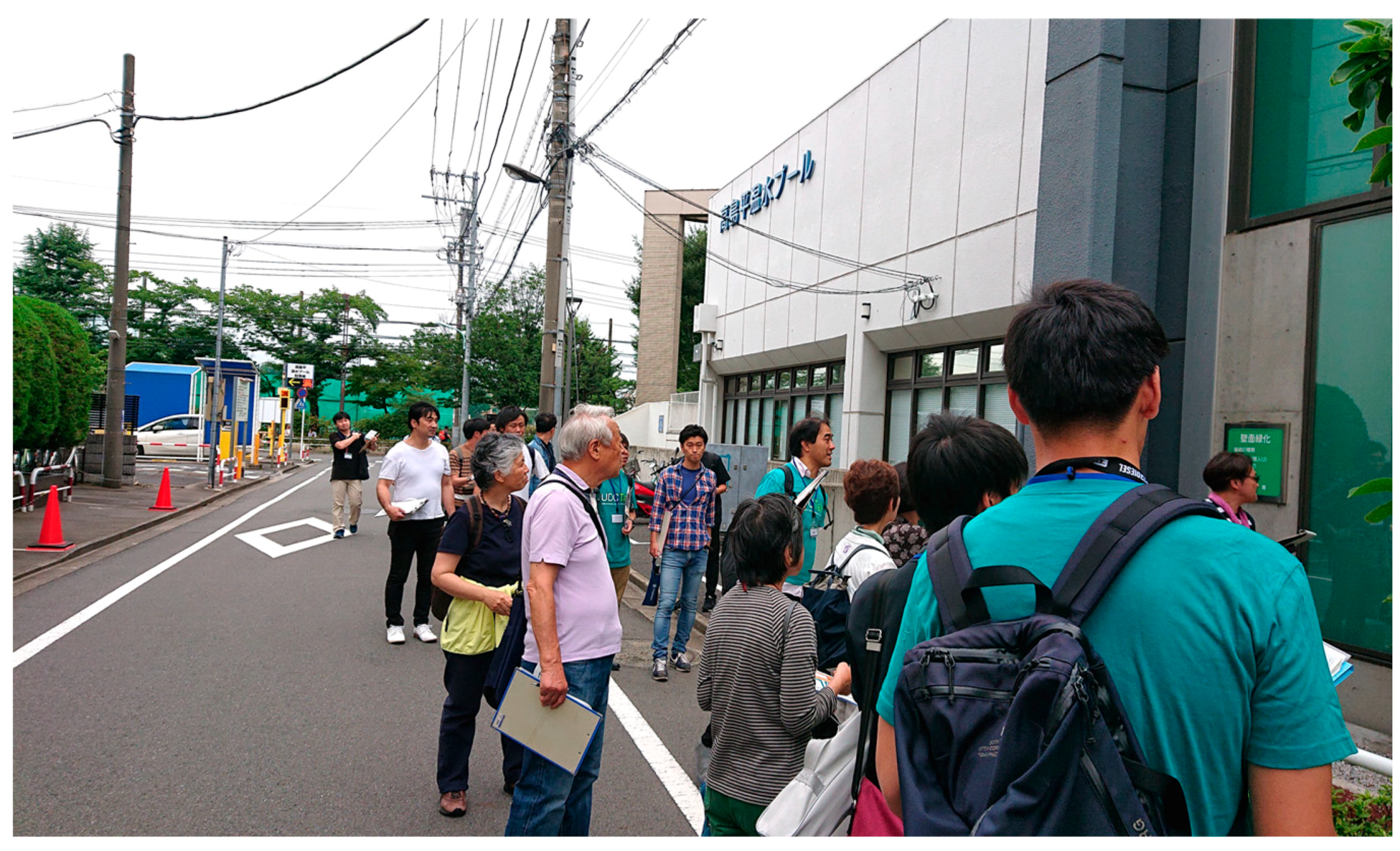
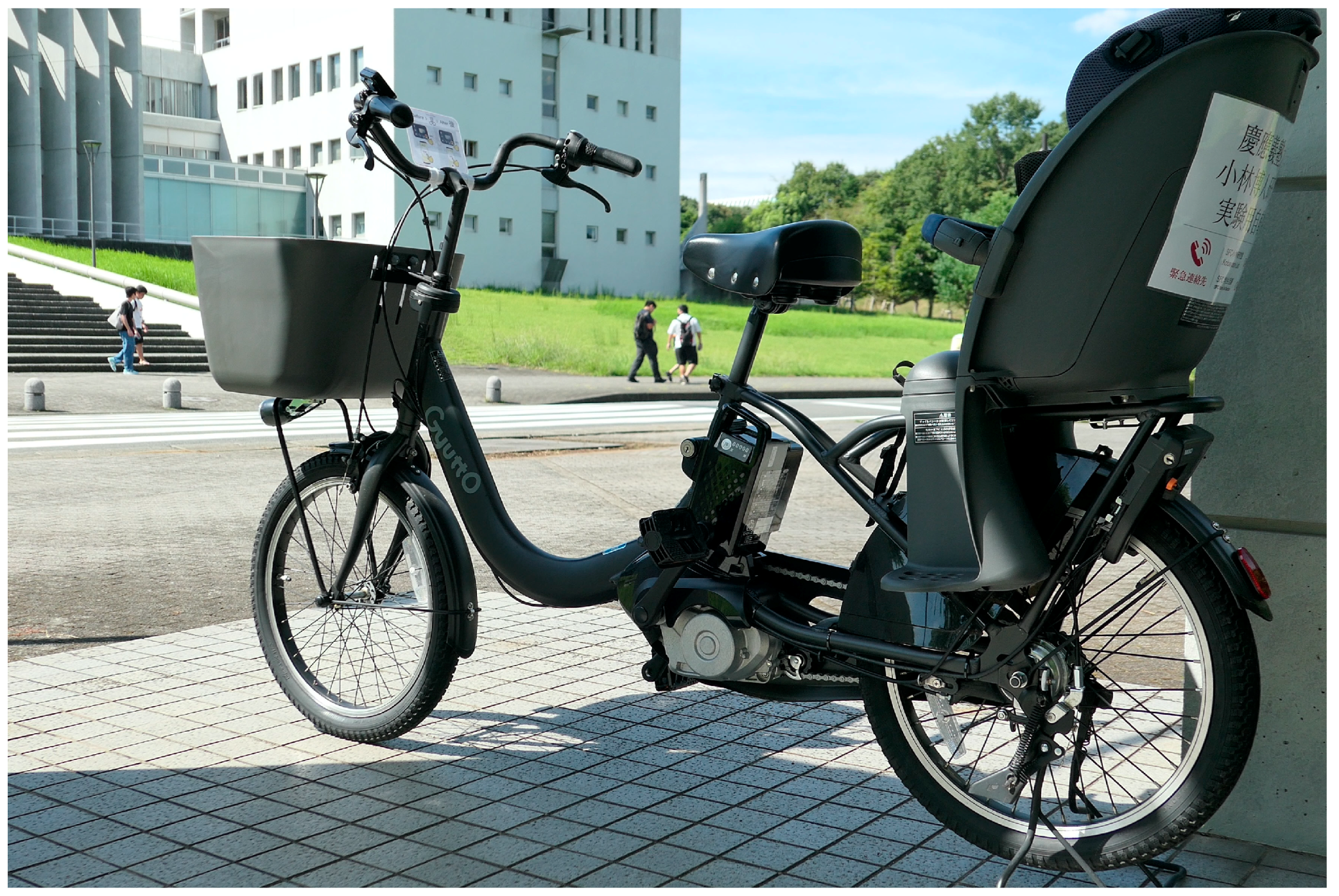
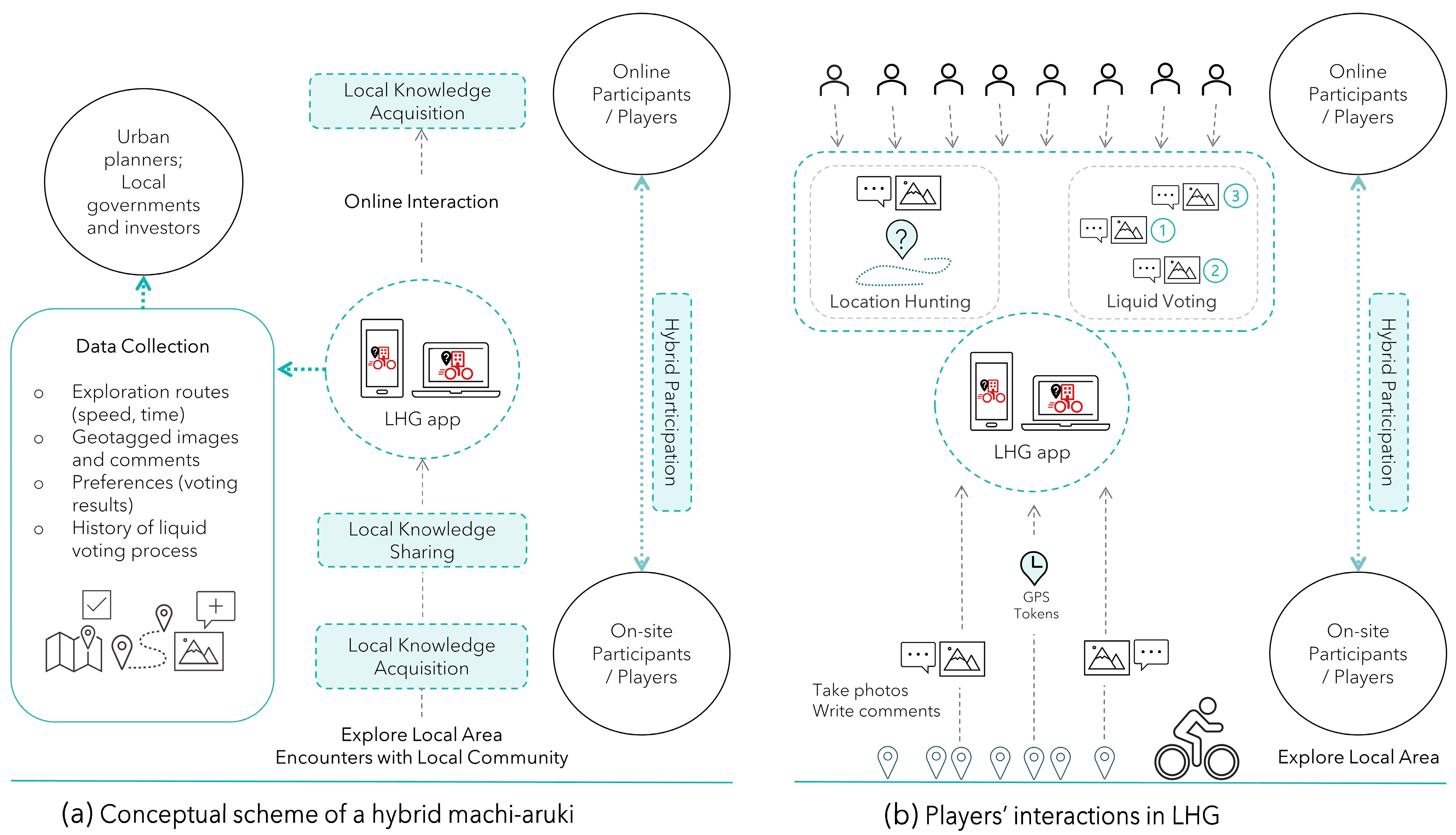
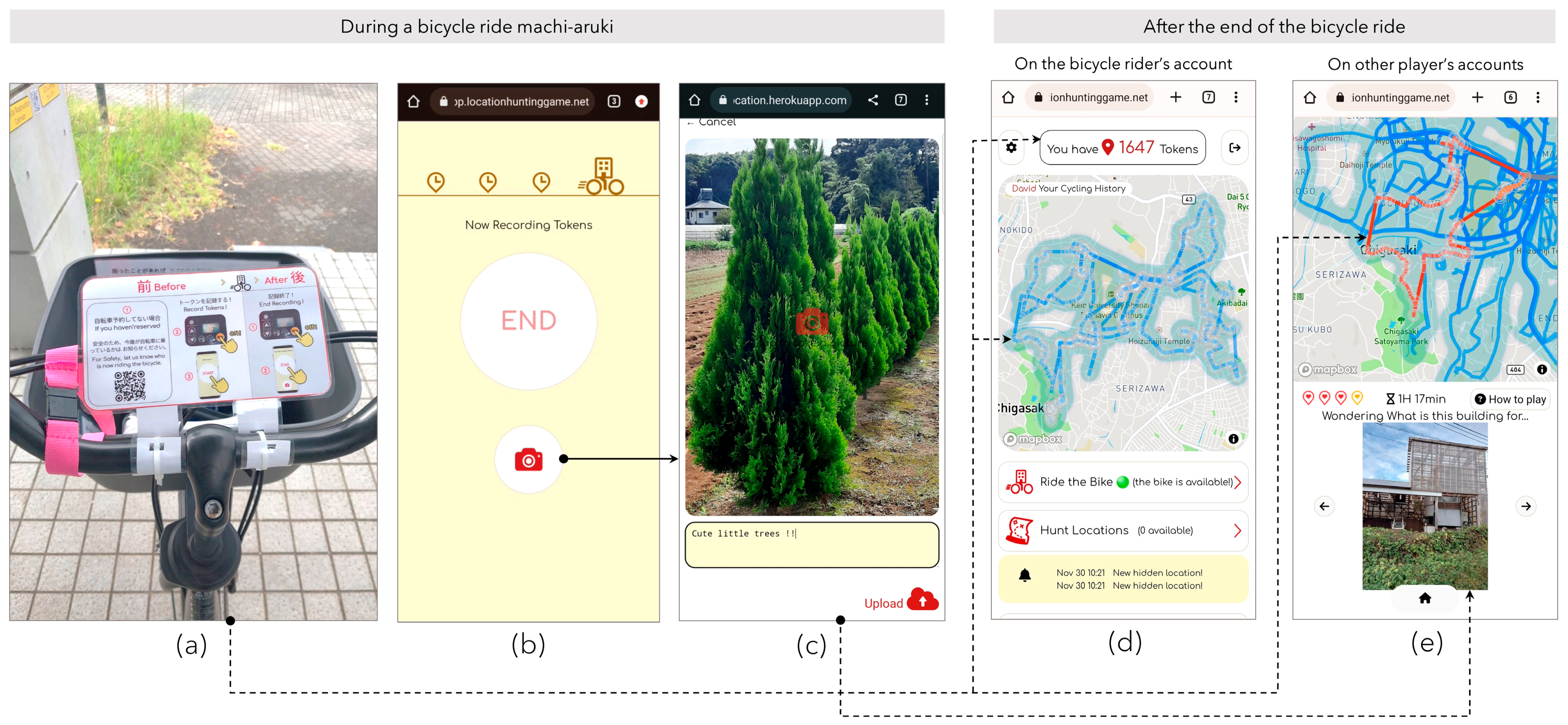
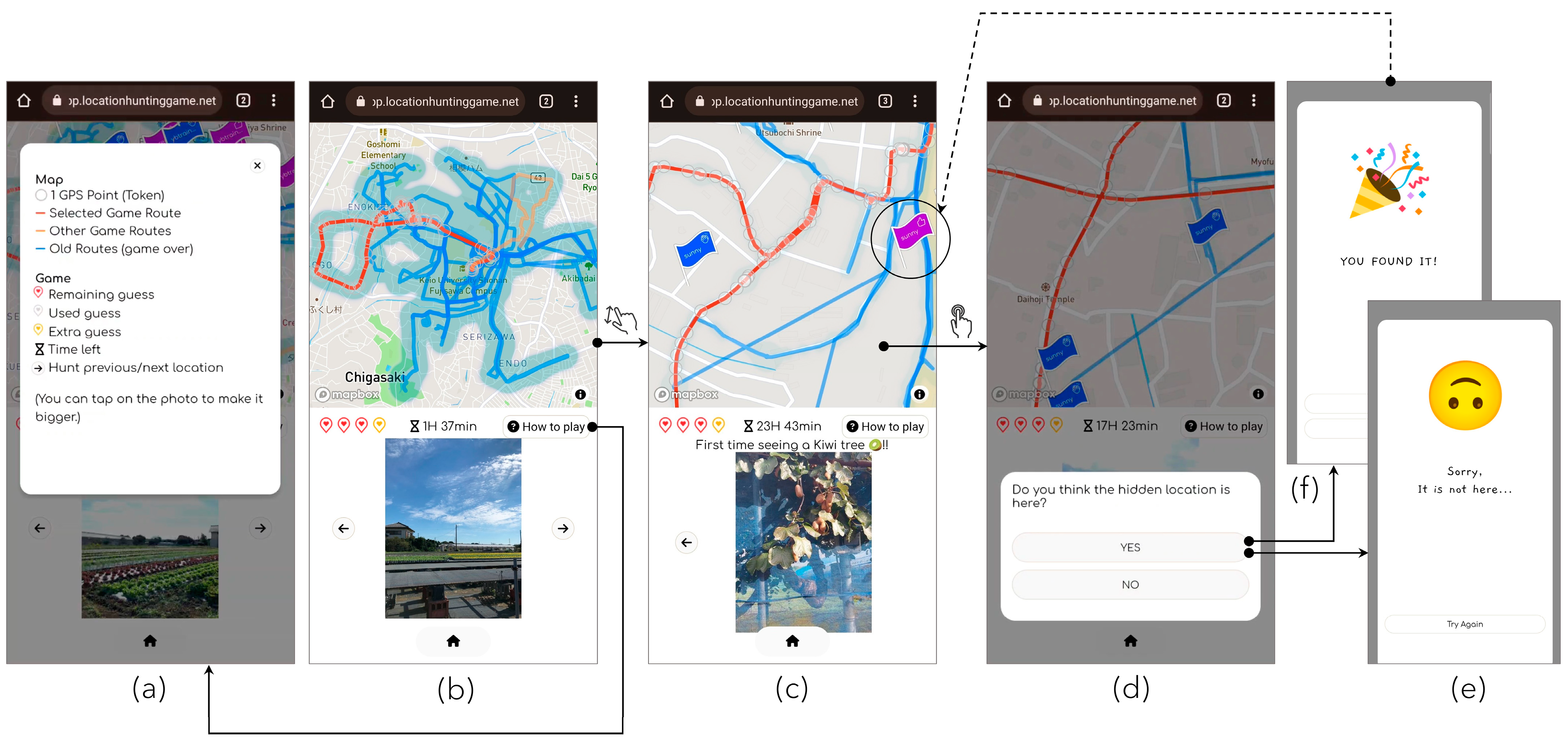
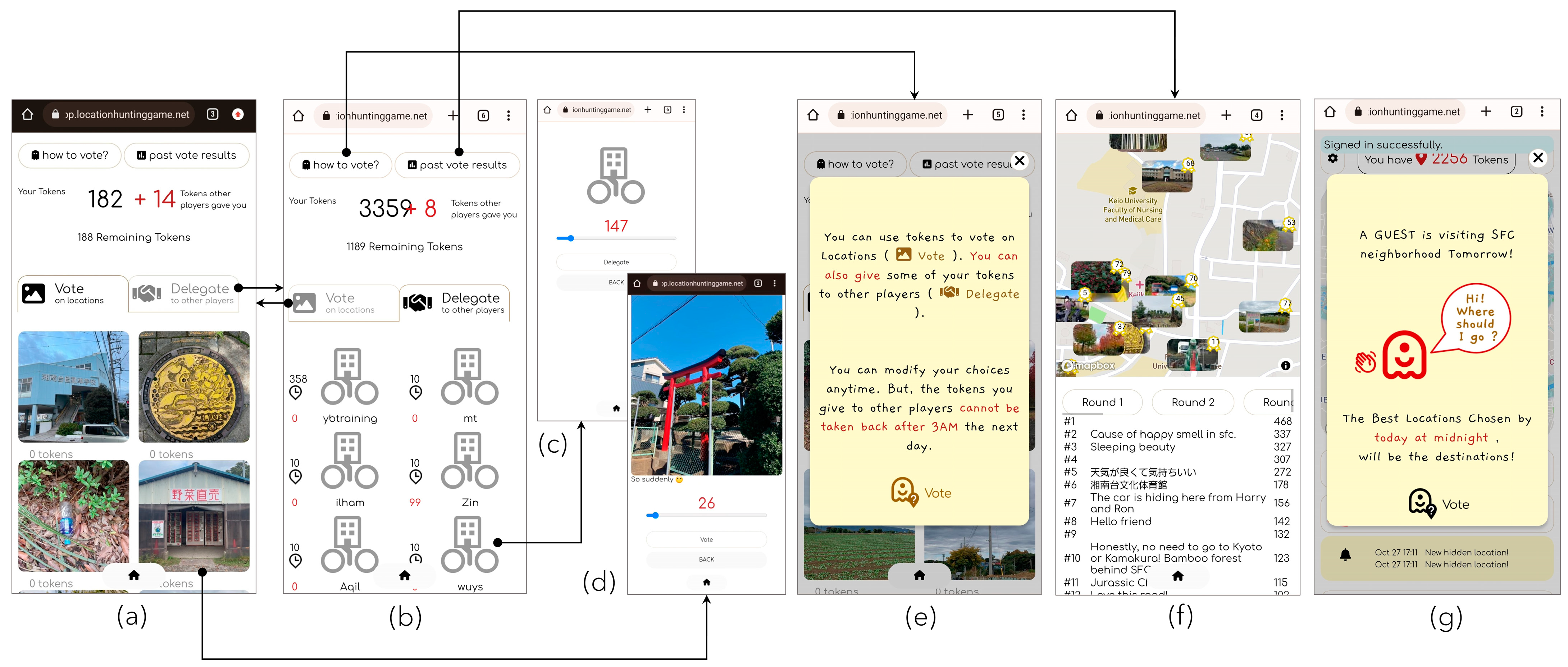
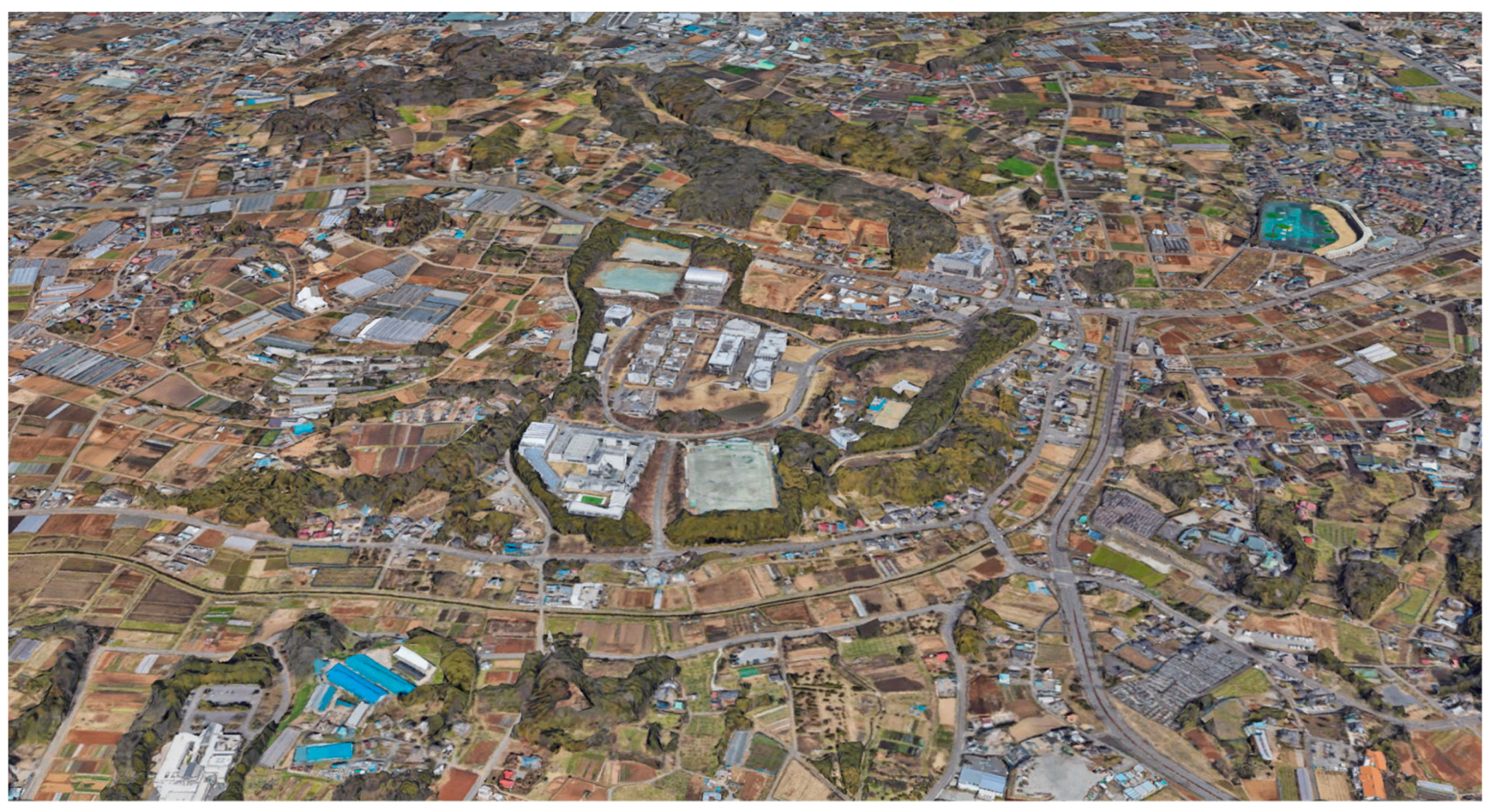
| Specification | Description |
|---|---|
| Machi-aruki and commentary |
|
| Hybrid participation |
|
| Gameful design |
|
| Data sharing and visualization |
|
| Location-based liquid voting |
|
| Crowdsourcing |
|
| Mockup | Prototype 1 (P1) | Prototype 2 (P2) | Improvements from P1 to P2 | |
|---|---|---|---|---|
| Home Screen | 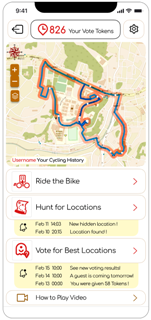 |  | 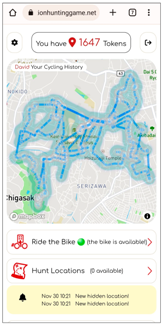 | Technical performance
|
| Hunt Locations | 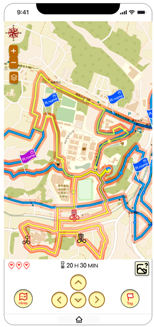 | 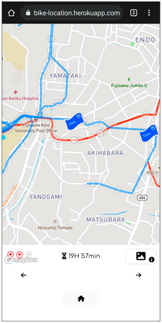 | 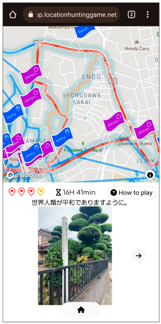 | Technical performance
|
| Voting (Delegation tab) | 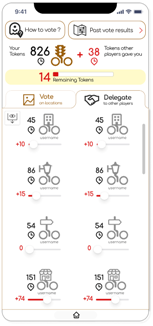 | 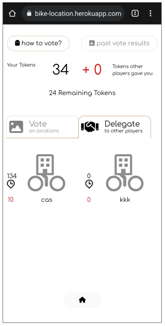 | 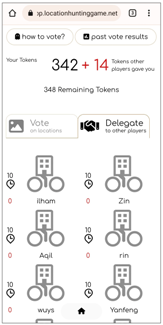 | App design elements
|
| Voting Results | 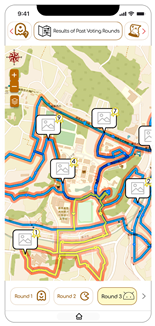 | 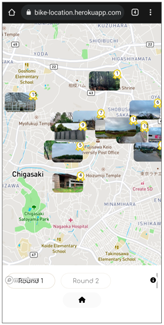 |  | Technical performance
|
| Characteristics | Umiaruki Issue Identification App [4] | Physical Accessibility Sharing Smartphone App [5,8] | Web AR App [41] | Disaster Information Tweeting and Mapping System (DITS/DIMS) [42] | Location Hunting Game (LHG) |
|---|---|---|---|---|---|
| Objective | Data collection for future decisions in urban planning To promote deliberations | Efficiency of data sharing with people with disabilities | Learn about visited areas and the local community | Review the town in terms of disaster prevention and mitigation, and promote self and mutual help by citizens | Promote the learning and sharing of local knowledge and build a common ground |
| Purpose of employing ICT tools | As a motivation for citizens and a data collection/ organization system | Data collection, organization, and visualization tool | Providing additional information for people during machi-aruki | Facilitate the posting and sharing of disaster-related information on Twitter | Enable a hybrid from of participation in machi-aruki and create a gameful experience |
| Gameful approach | No | No | No | No | Yes |
| Location tracking method | Smartphone GPS | Smartphone GPS | Smartphone GPS | Smartphone GPS | Electric bicycle’s GPS, Smartphone GPS |
| Testing format | Workshop format | Workshop format | Workshop format | Workshop format | Short-term Intervention |
| Number of participants in trial studies | 15 | 10 | 10 | 22 | 65 |
| Date and location | 2 September, 2010 Odaiba Seaside Park | Tokyo | Saturday, 16 April, 2022, 13:30–16:00 Hino City | 6 October 2018 Makomanai area, Minami Ward, Sapporo City | 6 weeks (between 10th Oct and 30th Nov 2022) Endo, Fujisawa City |
| Desired Outcome | LHG Interactions in | |
|---|---|---|
| The Physical World | The Digital World | |
| Local/spatial knowledge learning |
|
|
| Place attachment |
|
|
| Sense of community |
|
|
| Civic learning |
| |
| Enjoyment |
|
|
| Crowdsourcing |
| |
Disclaimer/Publisher’s Note: The statements, opinions and data contained in all publications are solely those of the individual author(s) and contributor(s) and not of MDPI and/or the editor(s). MDPI and/or the editor(s) disclaim responsibility for any injury to people or property resulting from any ideas, methods, instructions or products referred to in the content. |
© 2023 by the authors. Licensee MDPI, Basel, Switzerland. This article is an open access article distributed under the terms and conditions of the Creative Commons Attribution (CC BY) license (https://creativecommons.org/licenses/by/4.0/).
Share and Cite
Tabi, S.; Ikeda, Y. Location Hunting Game: Developing an Application to Promote Gameful Hybrid Machi-aruki Town Exploration. Urban Sci. 2023, 7, 126. https://doi.org/10.3390/urbansci7040126
Tabi S, Ikeda Y. Location Hunting Game: Developing an Application to Promote Gameful Hybrid Machi-aruki Town Exploration. Urban Science. 2023; 7(4):126. https://doi.org/10.3390/urbansci7040126
Chicago/Turabian StyleTabi, Salma, and Yasushi Ikeda. 2023. "Location Hunting Game: Developing an Application to Promote Gameful Hybrid Machi-aruki Town Exploration" Urban Science 7, no. 4: 126. https://doi.org/10.3390/urbansci7040126
APA StyleTabi, S., & Ikeda, Y. (2023). Location Hunting Game: Developing an Application to Promote Gameful Hybrid Machi-aruki Town Exploration. Urban Science, 7(4), 126. https://doi.org/10.3390/urbansci7040126





